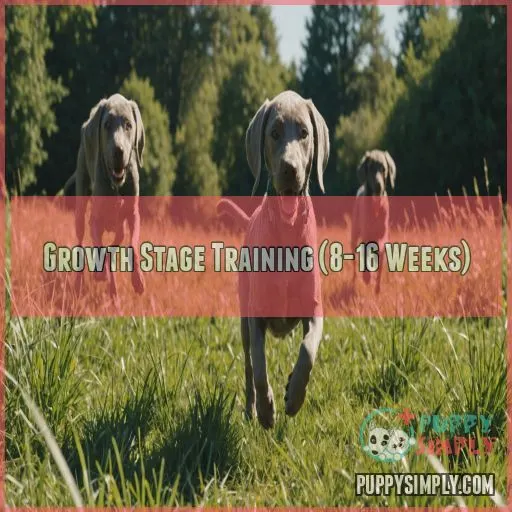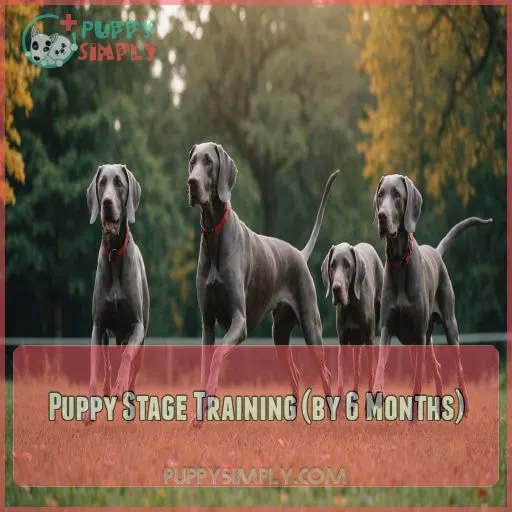This site is supported by our readers. We may earn a commission, at no cost to you, if you purchase through links.

Then, move on to growth stage training, mastering socialization, impulse control, and basic commands by 6 months.
By one year, your Weimaraner will be a well-rounded wonder, tackling advanced behaviors.
But don’t forget the critical socialization window – expose your pup to the world between 8-16 weeks for a confident, well-adjusted companion.
With patience and positive reinforcement, you’ll transform your high-energy Weimaraner into a true canine superstar.
The journey’s just beginning!
Table Of Contents
- Key Takeaways
- Weimaraner Puppy Foundation
- Growth Stage Training (8-16 Weeks)
- Puppy Stage Training (by 6 Months)
- Growth Stage Training (by One Year)
- Weimaraner Socialization Timeline
- Overcoming Weimaraner Training Challenges
- Advanced Weimaraner Training and Activities
- Frequently Asked Questions (FAQs)
- Are Weimaraners difficult to train?
- How to train a stubborn Weimaraner?
- What age do Weimaraners slow down?
- Do Weimaraners pick one person?
- How often should training sessions be?
- What type of training treats are best?
- How to address excessive barking?
- Can older Weimaraners be effectively trained?
- What are essential Weimaraner training tools?
- Conclusion
Key Takeaways
- Puppy-proof your home, build trust, and establish boundaries to set the foundation for your Weimaraner’s training journey.
- Harness your pup’s boundless energy through positive reinforcement, consistent socialization, and gradual exposure to the world – they’ll transform into a confident, well-adjusted companion.
- Mastering basic commands like "sit," "stay," and "come" by one year lays the groundwork for more advanced training, so get ready for some fun and games.
- Patience and consistency are the keys to tackling Weimaraner training challenges, from separation anxiety to excessive chewing. Stick with it, and you’ll have a canine superstar in no time.
Weimaraner Puppy Foundation
Getting started with your Weimaraner puppy is like preparing for a whirlwind of energy and affection, so you’ll need to set the stage right from the beginning.
Create a loving environment, establish some ground rules, and there’s no shame in bribing them with treats—it’s all part of the exciting (and occasionally chaotic) journey!
Creating a Safe Environment
Creating a safe environment for your Weimaraner puppy is really important. Think of your home as a fortress for curious explorers.
- Puppy-proof by removing chewable treasures like shoes and remote controls.
- Introduce calming routines with crate training to ease separation anxiety.
- Enrichment activities, like puzzle toys, foster impulse control and satisfy their curious minds.
Puppy-proofing is like childproofing—only hairier!
Building a Strong Relationship
Building a strong relationship with your Weimaraner puppy is the foundation for successful Weimaraner cluster training.
Focus on earning their trust through consistent, positive interactions.
Use lure reward training to reinforce desired behaviors and create a bond rooted in mutual understanding.
With patience and care, you’ll cultivate a lifelong partnership built on trust and communication.
Establishing Structure and Boundaries
You’ve started with a solid relationship, now let’s establish boundaries.
Crate training sets the stage for safe spaces.
Clear house rules keep the mischievous Weimaraner in check.
Teach play boundaries and leash manners—getting the hang of that loose lead is a game-changer.
With consistent structure in your "dog training cluster," your puppy will soon align with the breed standard.
Positive Reinforcement Training
Positive reinforcement with a Weimaraner isn’t just rewarding; it’s entertaining!
Picture teaching your dog life’s essential skills as if you’re a coach, guiding them to victory.
Use these steps:
- Timing: Reward immediately to build connections.
- Consistency: Make each success predictable.
- Tools: Treats and clicker training work wonders.
Oddly enough, you’ll start cheering for their smallest wins!
Importance of Socialization
While positive reinforcement builds trust, think of socialization as your Weimaraner’s passport to the world.
Like a gardener tending seedlings, it shapes them into confident, well-adjusted adults.
A well-socialized Weimaraner isn’t just a companion; they’re a canine good citizen.
So, sprinkle exposure like sunlight and let experiences bloom.
Here’s a quick guide to help with this growth:
| Socialization Aspect | Benefit |
|---|---|
| People | Confidence and trust |
| Noises | Reduced anxiety |
| Environments | Adaptability |
| Other dogs | Positive interactions |
Growth Stage Training (8-16 Weeks)
As your Weimaraner pup enters the growth stage between 8-16 weeks, it’s time to start socializing and exposing them to new things.
Get ready to familiarize your furry friend with all the sights, sounds, and experiences that will shape their confident, well-adjusted future.
Socialization and Exposure
In your Weimaraner puppy’s journey, early socialization is the magic ingredient in shaping their world outlook.
Think of it as giving them eyeglasses to see the world without fear.
Puppy exposure during this growth stage prevents a bunch of issues when adulthood rolls around.
You’ll dance around their prey drive and help craft confidence, just like training for a dog show!
Familiarization With Noises and Environments
Imagine yourself as the guide to your Weimaraner’s growing world.
Introduce it to traffic noises, public transport, and car rides to whip up its confidence.
Vet visits and body handling will soon feel like child’s play.
What a scene—your Weimaraner facing the bustling world, tail wagging!
You’re forming priceless bonds amid the hullabaloo of life.
Basic Impulse Control Training
During this growth stage, you’ll want to start teaching your Weimaraner puppy basic impulse control. Focus on the "sit" command – have them sit before meals, playtime, and other rewards. Use positive reinforcement like treats and praise to reinforce this behavior, even when faced with distractions. Mastering impulse control lays a solid foundation for their training journey.
To further develop impulse control:
- Practice the "sit" command in various environments with increasing distractions.
- Reward your pup with high-value treats when they resist the urge to jump or grab.
- Utilize training tools like clickers or a leash to guide them in the direction of the desired behavior.
Positive Associations With the World
Now that impulse control is in your toolkit, shift gears to create positive associations with the world.
Think of it as a puppy’s big adventure! Expose them to various sights, sounds, and smells. Pop by a local café or meet some friendly dogs.
Each experience boosts your puppy’s confidence and lays the groundwork for fear reduction and lifelong socialization benefits.
Puppy Stage Training (by 6 Months)
As your Weimaraner puppy approaches six months, it’s time to focus on teaching polite play, making housetraining progress, and reinforcing good behaviors.
You might find yourself begging your shoes to "sit" before the puppy, but with patience, your furry friend will learn to relax even when alone.
Polite Play and Bite Inhibition
Bite inhibition is really important, especially with those sharp puppy teeth.
Instead of letting your Weimaraner treat your hand like a chew toy, redirect play with socialization games and appropriate toys.
If your pup’s excitement turns into nibbling, halt play briefly. It’s like saying, "Hey, that’s not okay!" They’ll soon understand.
With consistency, you’re on the path to polite play.
Housetraining Progress
By this stage, housetraining should be a top priority.
Stick to a consistent potty break schedule, rewarding your pup with treats and praise each time they go in the right spot.
Accidents will happen – stay calm and simply clean it up without scolding.
Crate training can be a game-changer for housetraining success.
Hang in there – with patience and persistence, your pup will get the hang of it!
Alone Time Training
Imagine this: your Weimaraner chilling alone, not turning into a drama queen. It’s possible!
Start with crate training to mitigate separation anxiety.
Offer a chew toy for distraction, like a dog’s pacifier.
Gradually expose them to "me-time," increasing the duration slowly.
Impulse Control Reinforcement
Mastering impulse control in your Weimaraner puppy is a bit like teaching patience to a kid in a candy store! Use consistent training techniques and reward systems to teach "sit" before meals or play.
Timing is key, so catch them before they lose focus.
Expect distractions; they’re like squirrels to your dog. With persistence, your puppy will learn control!
Growth Stage Training (by One Year)
As your Weimaraner pup approaches one year, it’s time to focus on mastering basic behaviors like sit, stay, and come.
Don’t worry if they’re occasionally more entertained by a floating leaf than by you—consistency and positive reinforcement will keep them on track!
Mastering Basic Behaviors
By one year, your Weimaraner should be mastering the basics – sit, down, stay, come, and loose leash walking.
These foundational commands set the stage for more advanced training.
Reinforce these behaviors daily through positive reinforcement, and you’ll have a well-mannered pup in no time.
Three tips:
- Practice in short, frequent sessions.
- Use high-value treats to motivate your Weimaraner.
- Celebrate small wins to build confidence.
Sit, Down, Stay, Come, and Loose Leash Walking
Teaching your Weimaraner "sit," "down," "stay," "come," and mastering loose leash walking is like crafting a symphony. Each command needs patience and training consistency.
Navigate puppy distractions with rewards timed perfectly.
Loosen leash pressure as they learn; always encourage with positive reinforcement.
You’ll celebrate victories and share laughter as your bond strengthens.
Drop It and Leave It Commands
With puppies, "Drop it" and "Leave it" commands can be lifesavers, both figuratively and literally!
Imagine your curious Weimaraner deciding that socks are gourmet treats.
Using positive reinforcement, gently guide your pup to drop and leave tempting objects.
Train with real-world scenarios like toys or rocks, sidestepping safety concerns and curtailing training challenges while building alternative commands into your routine.
Complex Commands and Challenges
Get ready to tackle complex commands like retrieving and scent work—adventures your pup will adore!
Explore off-leash control and herding for a thrill that’ll test their noggin.
Sprinkle in agility tasks to harness that boundless energy.
With patience, you’ll tap into your Weimaraner’s true potential.
Let’s train and triumph together!
Continuous Positive Reinforcement
You’ve made it to the big leagues – your Weimaraner’s now a pro at the basics.
Time to kick things up a notch with continuous positive reinforcement.
Reward that pup every time they nail a command, no matter how small.
Timing is key – the instant they get it right, shower them with treats and praise.
Stay consistent, and watch their motivation soar.
Clicker training can work wonders too.
Weimaraner Socialization Timeline
Get ready to shape your Weimaraner puppy’s world outlook by understanding the critical socialization window between 57 and 112 days.
You’ll see your pup absorb new experiences like a sponge, laying the foundation for a confident, well-adjusted dog who doesn’t have to chase joggers down the street.
Critical Development Window (57-112 Days)
Your Weimaraner’s socialization magic happens between 57 and 112 days.
This is the time to fill their memory bank with positive experiences!
Think of this as building their world outlook.
Introducing new stimuli now, like bicycles or friendly strangers, helps prevent them from developing intense prey drives or fear periods later.
Memory Bank and Long-Term Memory
Ever wondered how puppy adventures shape their future selves?
During critical development periods, early experiences fill their memory bank like coins in a piggy bank.
The more positive puppy experiences they collect, the deeper they embed in long-term memory.
This treasure trove of memories influences behavior and gives them a confident edge.
Ready to fill that bank with golden moments?
Secondary Fear Period and Reduced Receptivity
After the important 16-week socialization window, your Weimaraner pup enters a secondary fear period where they’re less receptive to new experiences.
Don’t fret – this just means you’ll need to get creative with how you introduce them to the world.
Stick with positive reinforcement and make it an adventure you both enjoy!
World Outlook and Reaction to Unfamiliar Situations
Every dog’s world outlook is like a blank canvas waiting for colorful experiences.
Introduce your Weimaraner to various situations to paint a picture of confidence and adaptability.
Avoid fostering fear or anxiety by turning unexpected scenarios into familiar routines.
Your pup’s behavior will thank you, transforming apprehension into curiosity.
Prey Drive and High-Energy Breeds
Understanding your Weimaraner’s prey drive is key to channeling that boundless energy constructively.
Think of it as their inner superhero trying to save the world—sometimes from a plastic bag!
Encourage safe play and mental stimulation to manage their instincts.
Use exercise and training tips to prevent chaos.
Resources for owners help you master control and tame the whirlwind.
Overcoming Weimaraner Training Challenges
Facing Weimaraner training challenges might feel tough, but you’ve got this!
With their boundless energy and strong personalities, these pups will keep you guessing (and maybe chasing them around the yard), so let’s tackle their quirks together.
Separation Anxiety and Alone Time
Weimaraners can struggle with separation anxiety, but don’t worry – you’ve got this!
Start by getting your pup comfy in a cozy crate, then slowly build up their alone time.
Use calming music, treats, and praise to make solo sessions a breeze.
With patience and consistency, you’ll have a confident, content companion.
High Energy Levels and Exercise Needs
Got a high-energy Weimaraner bouncing off the walls? Let’s harness that energy! Establish a daily exercise routine that includes activities like jogging or hiking to satisfy their breed-specific needs.
But don’t stop there—mix in mental stimulation with puzzle toys or training sessions.
These energy outlets will help create an active lifestyle that keeps both you and your pup engaged and happy.
Chewing Instinct and Rock Chewing Prevention
Rock-chewing is a Weimaraner’s secret hobby, but it can wreak havoc on teeth.
Here are three engaging alternatives:
- Safe Chewing Options: Offer tasty chew toys to satisfy the craving.
- Muzzle Training: Use a comfy muzzle as a gentle deterrent.
- Treat Trading: Teach your pup to trade rocks for treats, turning it into a fun game.
Keep those pearly whites safe!
Positive Reinforcement Techniques
Imagine you’ve got a toolbelt full of rewards, timing, and praise!
When your Weimaraner does something right, sprinkle a little praise with a treat – it’s like magic!
Pay attention to timing, ensuring your dog associates the reward with the action.
Your consistent praise makes training smoother, and turns you into a confident, masterful dog whisperer!
Consistency and Patience
Consistency and patience are the cornerstones of successful Weimaraner training. Stick to your guns, my friend! Reward-based training takes time, but the payoff is a well-behaved pup who trusts you.
Here’s why it’s worth the effort:
- Builds a stronger bond between you and your furry companion.
- Helps your Weimaraner feel secure and confident.
- Prevents frustration and setbacks in the long run.
- Makes sure your dog’s training sticks, even when life gets busy.
Advanced Weimaraner Training and Activities
As you venture into advanced Weimaraner training and activities, prepare for a thrilling journey filled with agility games, graceful showmanship, and complex obedience challenges.
Your energetic Weim may mistake your socks for chew toys, but with patience, you’ll both master new skills, keeping your clever companion engaged and happy.
Agility Training and Fieldwork
Harness your Weimaraner’s boundless energy by diving into agility training and fieldwork!
With the right agility equipment and field trial prep, you’ll channel their natural herding instincts and flair for scent work.
Explore diverse training resources, turning exercises into bonding adventures.
Conformation and Showmanship
Bouncing from agility training, let’s talk showmanship. Face show ring triumph with flair by mastering:
- Show Ring Etiquette: Strut like you own the joint.
- Grooming Tips: Keep coats sleek.
- Breed Standards: Highlight Weimaraner charms.
- Judge Selection: Choose those with a gentle hand.
Prepping puppies? It’s like herding cats, but the rewards are positive!
Advanced Obedience Commands
As your Weimaraner masters the basics, it’s time to level up!
Teach advanced commands like Heel, Stay, Fetch, and Retrieve.
These challenges will keep your pup’s mind sharp and strengthen your bond.
Soon, you’ll have a canine companion worthy of the show ring!
Problem Prevention and Correction
Tackling common Weimaraner problems like chewing or separation anxiety? Here’s the skinny: 1. For aggressive chewing, provide tasty, safe alternatives—your pup will thank you! 2. Combat separation anxiety with gradual alone-time exercises; Rome wasn’t built in a day.
- Address socialization issues early—expose your dog to varied experiences, like meeting Joe from next door or that darn squeaky vacuum.
Continuous Learning and Growth
Training never really ends with Weimaraners. Just like us, they thrive on lifelong learning. Engage your pup with advanced Weimaraner training and keep that dog development going strong with expert cluster training tips.
Mental stimulation’s key; think of it as brain gymnastics.
Don’t forget, owner education‘s equally important. Stay sharp, and watch your furry Einstein impress with newfound tricks and skills!
Frequently Asked Questions (FAQs)
Are Weimaraners difficult to train?
Training a Weimaraner is like guiding a wildfire—they’re energetic and enthusiastic but need direction.
Patience, consistency, and early socialization are key.
You’ll find their loyalty and intelligence make training rewarding with the right approach.
How to train a stubborn Weimaraner?
You can harness that stubborn Weimaraner energy with positive reinforcement.
Turn training into a fun game.
Make it rewarding with treats and praise.
Consistent house rules and patience work wonders, transforming stubbornness into steadfast loyalty.
What age do Weimaraners slow down?
Weimaraners typically start slowing down around 5-7 years old, but every dog is different.
It’s all about finding the right balance for your pup.
Keep them active and engaged, and they may maintain their high energy well into their senior years.
Do Weimaraners pick one person?
Imagine a dog that’s like a trusty sidekick, forming a deep bond with someone special.
Weimaraners often choose one person as their favorite, showering them with loyalty and affection, making for a heartwarming friendship.
How often should training sessions be?
Training sessions should happen consistently but not exhaustively—think quality over quantity.
Aim for brief, engaging sessions two to three times a day.
It’s like learning to dance; repetition builds confidence without stepping on toes.
What type of training treats are best?
You might want to try small, soft treats that your Weimaraner can gobble quickly—think of them as little bites of gold.
It’s like handing out candy in a classroom; you’ll keep their attention without distractions.
How to address excessive barking?
Don’t let excessive barking drive you barking mad!
Try redirecting your Weimaraner’s energy with interactive toys, extra exercise, and positive reinforcement training.
With patience and consistency, you can curb that yapping in no time.
Can older Weimaraners be effectively trained?
Older Weimaraners can still learn new tricks!
Focus on creating a positive, structured environment and use reward-based training.
It’s never too late to teach a seasoned dog new skills, while strengthening your bond.
What are essential Weimaraner training tools?
Imagine a toolbox of magic tricks: a clicker for precise communication, treats for rewarding good behavior, a leash for guidance, and toys to channel energy.
These tools all help you shape your Weimaraner’s journey!
Conclusion
Much like sculpting a masterpiece, training your Weimaraner is an art filled with patience and joy.
Remember, your Weimaraner cluster training timeline is a journey, guiding your pup from chaotic to calm, from energetic to engaged.
Embrace each moment—setbacks and successes alike—as you nurture a balanced, happy companion.
With consistency, a pinch of humor, and lots of love, you’ll mold a magnificent canine capable of incredible bond and adventure.
Ready? Set? Let’s conquer this journey together!









